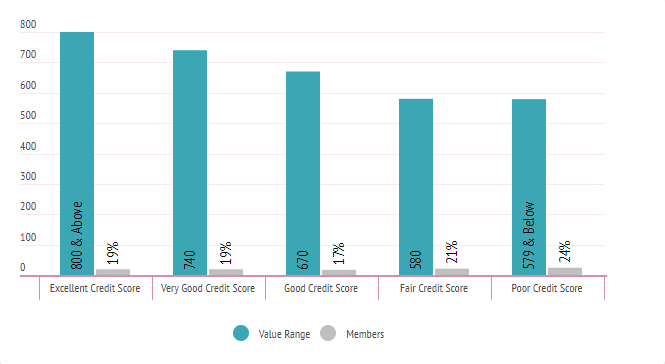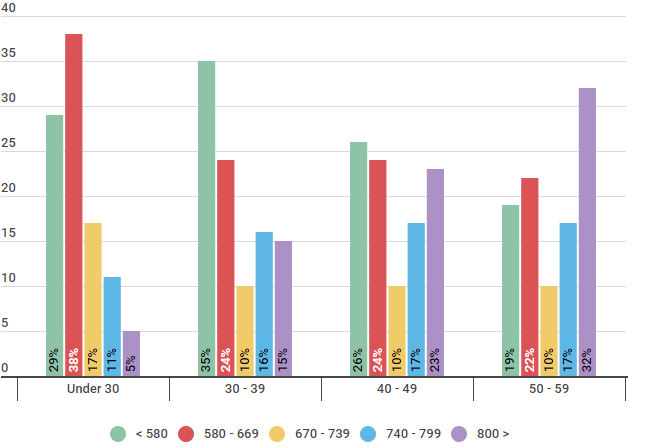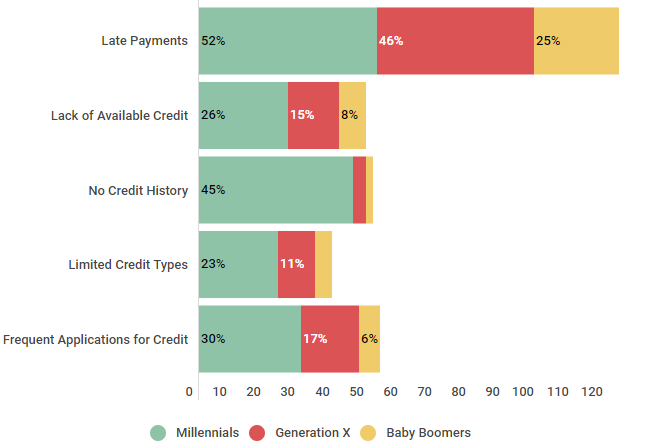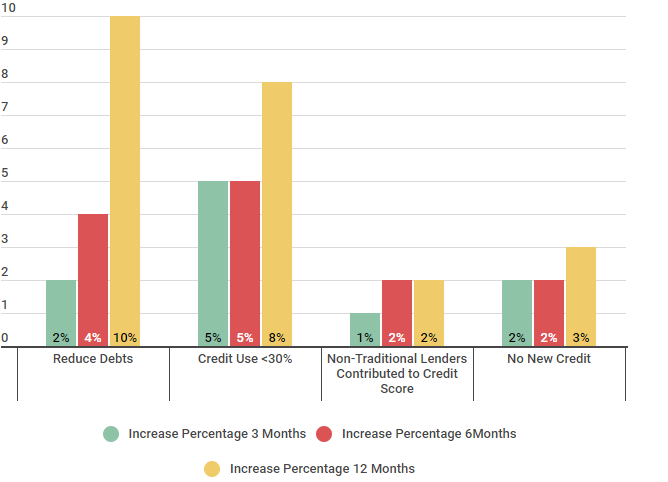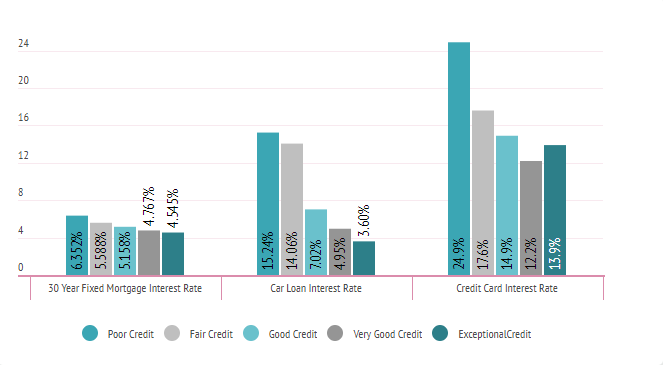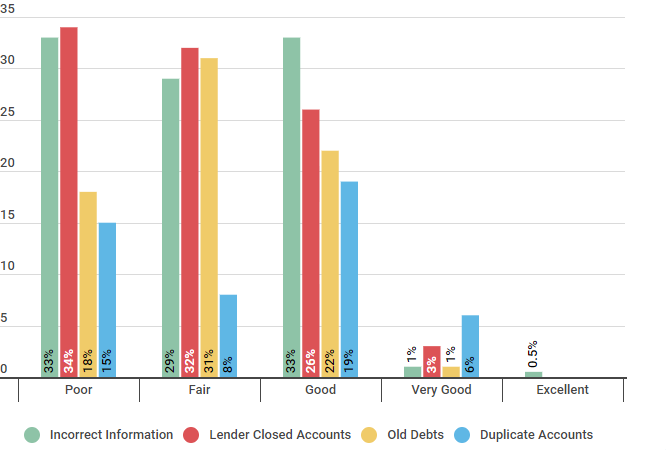Your credit score is a three-digit number, made up by a variety of factors, that gives lenders a snapshot into your creditworthiness. In this article, we’ll look at the credit score of 640, whether that’s good or bad, what you can expect with that score, and more.
Is a 640 credit score good?
Before we look at whether or not a 640 credit score is good, it’s important to note that we’re talking about your FICO score. Both FICO and VantageScore are “brands” of credit scores, with FICO being the most common and widely accepted.
As you can see from the chart below, a credit score of 640 is most often considered Fair credit, as it falls in the range of 550 to 669. However, if you have a credit score that falls in this range, you’re not alone. Roughly 15 percent of Credit Sesame members fall into this category.
While there are lenders that will certainly extend credit to you with a 640 score, you may not get the same interest rates or terms that someone with a higher score would be offered. That said, with a 640 credit score, you’re only 10 points away from falling into the “Fair” category —where roughly 21 percent of Credit Sesame members find their score.
Comparing Credit Score Ranges of Credit Sesame Members
| Score Range | Value Range | Members |
|---|---|---|
| Excellent Credit Score | 800 & Above | 19% |
| Very Good Credit Score | 740 - 799 | 19% |
| Good Credit Score | 670 - 739 | 17% |
| Fair Credit Score | 580 - 669 | 21% |
| Poor Credit Score | 579 & Below | 24% |
Source: Credit scores were calculated from 5,000 Credit Sesame members on 2/6/18.
Similarly, as you can see from the data below, approximately 24 percent of the U.S. population aged 30-39 find themselves with a score between 580 and 669. This increases to 38 percent for those under the age of 30.
U.S. Population Categorized by FICO Range & Credit Scores
| Age | < 580 | 580 - 669 | 670 - 739 | 740 - 799 | 800 > |
|---|---|---|---|---|---|
| Under 30 | 29% | 38% | 17% | 11% | 5% |
| 30 - 39 | 35% | 24% | 10% | 16% | 15% |
| 40 - 49 | 26% | 24% | 10% | 17% | 23% |
| 50 - 59 | 19% | 22% | 10% | 17% | 32% |
Source: Experian’s State of Credit 2017.
If you’re not 100 percent happy with your 640 credit score, don’t worry. The fact that you know what your score is, is the first step in improving it. There are things that you can take to improve your score. Keep reading to learn more about the factors that go into this calculation and some basics on how to improve your score.
Factors that make up your credit score
While there are a wealth of strategies for improving your 640 credit score, the most important first step is understanding how your credit score is calculated. Take a look at the chart below. It shows the factors that make up your score, as well as the weight that is given to each.
FICO Scoring Model Calculation (Weight) Factors
| Credit Factors | Credit Score Weight |
|---|---|
| Payment History | 35% |
| Credit Utilization | 30% |
| Credit Age | 15% |
| Different Types of Credit | 10% |
| Number of Inquiries | 10% |
Source: https://www.myfico.com/credit-education/whats-in-your-credit-score
You’ll notice that your payment history, as you might expect, has the most weight when calculating your score. Second is your credit utilization, which can most easily be described as the debt you have vs. your available credit limits. The age of your open credit accounts, the mix of different types of credit, and the number of credit inquiries also play a role.
As we look at ways to improve your 640 credit score, you’ll see that many of the strategies are aligned with these different factors —and improving them. Let’s look at those now.
How to improve your 640 credit score
Below are some of the most common negative factors that can contribute to having a Fair credit score. As we discussed, you’ll notice that they align with many of the factors that make up your score.
Negative Factors that Contribute to Low Credit Scores
| Negative Factors | Millennials | Generation X | Baby Boomers |
|---|---|---|---|
| Late Payments | 52% | 46% | 25% |
| Lack of Available Credit | 26% | 15% | 8% |
| No Credit History | 45% | 4% | 2% |
| Limited Credit Types | 23% | 11% | 5% |
| Frequent Applications for Credit | 30% | 17% | 6% |
Source: Credit Sesame polled 300 participants between February 10, 2018, and February 17, 2018. 100 participants were Millennials, 100 participants were members of Generation X, and 100 participants were Baby Boomers.
From this data, we can also see that having no credit history and late payments are big factors for the Millennial generation, while Generation X sees late payments as their biggest negative factor. For Baby Boomers, late payments are also the biggest contributor to a Fair score.
If you think you’d like to improve your score, the good news is that it’s completely doable with some effort, some time, and some direction. Below, you can see the results Credit Sesame members were able to see in three months, six months, and 12-months by focusing on items like reducing their debts, lowering their credit use and more.
How to Improve a Fair Credit Ranking Within a Year
| 640 Credit Score | Increase Percentage 3 Months | Increase Percentage 6 Months | Increase Percentage 12 Months |
|---|---|---|---|
| Reduce Debts | 2% | 4% | 10% |
| Credit Use <30% | 5% | 5% | 8% |
| Non-Traditional Lenders Contributed to Credit Score | 1% | 2% | 2% |
| No New Credit | 2% | 2% | 3% |
Source: Credit Sesame asked 200 Members with a base credit score of 640 who individually utilized the listed methods. The survey was conducted from August 2016 to August 2017.
To learn more about specific strategies you can use to improve your 640 credit score, explore our recent article on credit score improvement.
If you’re not quite ready to take steps toward improving your credit or just want to see what you can get with a 640, keep reading.
| Free credit score |
|---|
| Is 640 a good credit score |
| How to improve your credit score |
What can you expect with a 640 credit score?
With a 640 credit score, you are considered to have Fair credit. While you can still find lenders that will help you finance a home or car, the interest rates you receive may not be as favorable as those someone might receive if they had Good or Excellent credit.
Below are the interest rates that Credit Sesame members of different credit score ranges received when applying for a 30-year fixed mortgage, a car loan and a credit card.
Average Interest Rates Divided by Credit Score Range
| Type of Loan | Poor Credit | Fair Credit | Good Credit | Very Good Cred | Exceptional Credit |
|---|---|---|---|---|---|
| 30 Year Fixed Mortgage Interest Rate | 6.352% | 5.588% | 5.158% | 4.767% | 4.545% |
| Car Loan Interest Rate | 15.24% | 14.06% | 7.02% | 4.95% | 3.60% |
| Credit Card Interest Rate | 24.9% | 17.6% | 14.9% | 12.2% | 13.9% |
Source: Credit Sesame asked 400 members about their interest rates during a three week period beginning on January 18, 2018.
As you can see, having Fair credit means that the interest rates are higher — and, the better your credit score the lower (and therefore better) the interest rate.
But what does this really mean for you? Here is a real-life example to help you put it in perspective.
If you purchase a $150,000 home with an interest rate of 6.2 percent, over the course of 30 years, you’ll have paid roughly $162,660 in interest. However, if you purchase that same $150,000 home with an interest rate of four percent, you’ll have paid roughly $97,024 in interest over the same 30 years.
When you do the math, it’s easy to see the overall impact your credit score can have on your wallet.
How to deal with negative information on your credit report
Now that we’ve looked at what a 640 credit score is, what it can get you, and some basic strategies on how to improve your score, it’s important to address how you should deal with negative information on your report.
While some negative information on your report may be the result of poor credit decisions on your part, there are also errors (by no fault of your own) that can cause your score to be lower than ideal
Errors Which Affect Credit Rankings
| Credit Ranking | Incorrect Information | Lender Closed Accounts | Old Debts | Duplicate Accounts |
|---|---|---|---|---|
| Poor | 33% | 34% | 18% | 15% |
| Fair | 29% | 32% | 31% | 8% |
| Good | 33% | 26% | 22% | 19% |
| Very Good | 1% | 3% | 1% | 6% |
| Excellent | 0.5% | N/A | N/A | N/A |
Source: Credit Sesame surveyed 250 people, 50 had a Poor credit ranking, 50 participants had a Fair credit score, 50 members had a Good credit rating, 50 people were listed as Very Good, and 50 members reported they had an Excellent credit score. The study was conducted on October 20, 2017, over a period of two weeks.
As you can see, 29 percent of Credit Sesame members with Fair credit saw incorrect information on their report. Similarly, 32 percent found that lender closed accounts were contributing to their low score, as were old debts (31 percent) and duplicate accounts (8 percent).
This is why it is important to monitor your credit report at least annually to check for any inaccuracies. If you find something that isn’t right, you should file a dispute with the credit bureau.
Once you’ve cleared up any inaccuracies, you should shift your focus to the credit-improvement strategies we touched on earlier.
How Pam improved her 640 credit score to 704 in two years
The great thing about your credit score is that it’s not fixed; you can always improve it. We recently spoke with Pam, a Credit Sesame member who was able to improve her 640 credit score to a 704 in just two years. Here is her story.
Member Since: 2/23/2016
| We interviewed Pam on May 18, 2018; she earns $51,000 a year, is 37 years old and lives in South Valley, N.M. She is recently married and looking to purchase a home with her husband next year. | |||||||||||||||||||||||
|---|---|---|---|---|---|---|---|---|---|---|---|---|---|---|---|---|---|---|---|---|---|---|---|
| What | did | you | do | to | improve | your | 640 | credit | score? | ||||||||||||||
| I’ve learned that maintaining a healthy credit rating requires routine monitoring, and the ability to stick to a realistic budget. I stopped using my credit card for unnecessary purchases, like a $4 coffee every morning and stuck to my budget. I diligently pay my bills on time and I pay down my overall debts every chance I get. | |||||||||||||||||||||||
| What | is | your | credit | score | now? | ||||||||||||||||||
| I’m | really | proud | to | say | that | my | score | has | grown | to | 704. | I | think | I | can | get | it | even | higher | in | the | next | year. |
| How | long | did | it | take | to | improve | your | 640 | score? | ||||||||||||||
| It has taken me two years to raise my credit score from 640 to 704. The major change for me was adjusting my spending habits, so it was more of a gradual change. |
Pam’s story is a great reminder that little things like skipping her morning coffee to pay down her debt diligently can have a big impact on one’s overall financial position.
TLDR; what can you do with a 640 credit score and beyond?
In summary, a 640 credit score is generally considered to fall in the Fair range, which is 550 to 669. While a 640 isn’t the best score, roughly 21 percent of the U.S. population falls into a similar credit score rage. There are plenty of lenders that will still extend credit to someone with a 640 score, but the terms may not be as favorable as those extended to someone with better credit.
The good news is that improving a 640 credit score can be done, as was demonstrated by Pam who was able to improve her score to a 704 in just two years — placing her in the Good credit score range. It’s never too late to start working to improve your credit score.













